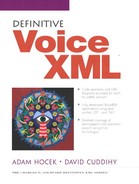3.24. item
DTD
<!ELEMENT item (%rule-expansion; | tag)* > <!ATTLIST item weight NMTOKEN #IMPLIED repeat CDATA #IMPLIED xml:lang NMTOKEN #IMPLIED >
Language model

Attributes
repeat : CDATA
Specifies that the contents of this item may be heard repeatedly. The permissible patterns of repeat may be expressed as in Table 3-2.
tag : CDATA (deprecated)
In the early version of the VoiceXML 2.0 Specification the tag attribute represented an expression to be interpreted if this item element's rule-expansion is matched. This is typically an ECMAScript expression.
weight : NMTOKEN
Specifies the expected probability of this item's rule-expansion being spoken. This is used to provide a hint to the speech recognition engine.
xml:lang : NMTOKEN
Specifies the spoken language used with this element. For example, en-US for US English.
Children
A rule-expansion
To be enumerated within a one-of element.
Examples
Example 3-27. A weighted grammar definition
<?xml version="1.0" encoding="iso-8859-1"?>
<vxml version="2.0">
<form id="test">
<field name="favcolor">
<prompt>What is your favorite color?</prompt>
<grammar xml:lang="en-US" version="1.0" root="colors">
<rule id="colors" scope="public">
<one-of>
<item><tag>red</tag>red</item>
<item weight="0.5"><tag>red</tag>burgundy</item>
<item><tag>blue</tag>blue</item>
<item weight="0.5"><tag>blue</tag>indigo</item>
<item><tag>green</tag>green</item>
</one-of>
</rule>
</grammar>
<filled>
<prompt>
You said <value expr="favcolor"/>.
</prompt>
</filled>
</field>
</form>
</vxml>
|
An example of the deprecated form of item where the tag attribute is used is shown for the grammar element in 3.20, “grammar,”.
Example 3-28. The deprecated count element
Though the count element is now deprecated, on many interpreters, the count element (Example 3-28) is still the only way to indicate a repeat or an optional rule expansion.
